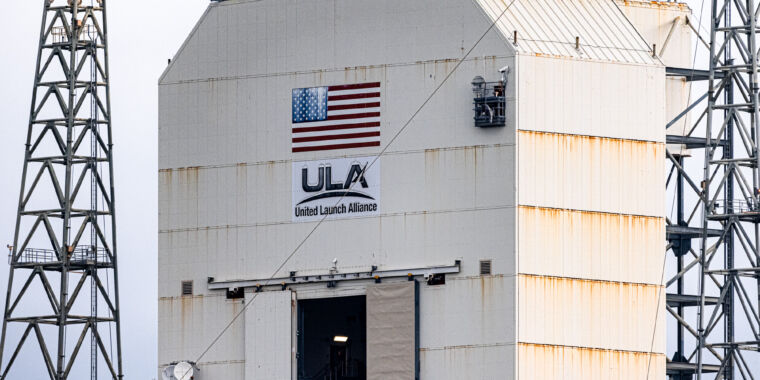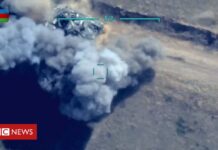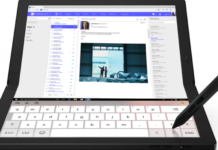
-
Delta IV Heavy nestled in its Mobile Service Tower before launch of the NROL-44 mission for the National Reconnaissance Office.
Trevor Mahlmann for Ars -
Close-up of Delta IV Heavy in the Mobile Service Tower.
Trevor Mahlmann for Ars -
The weather on Tuesday delayed launch preparations.
Trevor Mahlmann for Ars -
The launch infrastructure supporting the Delta IV rocket is about two decades old.
Trevor Mahlmann for Ars -
There is a lot of it involved in a launch.
Trevor Mahlmann for Ars -
The Delta IV rocket is seen outside of its Mobile Service Tower.
Trevor Mahlmann for Ars
United Launch Alliance has been attempting to launch a spy satellite for the National Reconnaissance Office, valued at more than $1 billion, for quite a while now. On Tuesday evening, just hours before the company’s latest attempt to launch the large Delta IV Heavy booster, the mission was scrubbed again.
The weather at the launch site was far from optimal, but the mission was delayed due to a technical problem with the launch pad. What is notable is that this is now the third issue that the company, ULA, has experienced with its ground systems equipment at Space Launch Complex-37 in Cape Canaveral, Florida for this flight.
The mission, dubbed NROL-44, was originally due to launch in June. When it was delayed until late August, military officials did not cite a reason for the schedule slip. However, on August 29, everything seemed nominal as the three-core rocket counted down to liftoff from its Florida-based launch pad. The countdown reached zero, the three main RS-68 engines ignited, and the launch conductor said, “Liftoff!”
But the rocket did not lift off. Instead, even as fires rose around the three cores, the rocket stayed put during a hotfire abort. This last-second scrub delayed the mission for a few weeks as engineers investigated the issue and eventually determined that a ground systems regulator caused the launch to abort. Essentially, three of these regulators at the pad deliver high-pressure helium into the main engines. The regulator for the center core engine failed.
On Twitter, the company’s chief executive, Tory Bruno, wrote, “Found root cause of the pad side stuck regulator. Torn diaphragm, which can occur over time. Verifying the condition of the other 2 reg’s. We will replace or rebuild as needed.” Eventually the company would remove the regulators for all three engines, refurbish, and reinstall them. (Bruno did not respond to a request for comment for this story.)
Nearly a month later, the company again prepared to launch the NROL-44 mission, even passing a launch readiness review. Then, a day before the September 26 launch date, the company delayed liftoff again. This time the culprit was a problem with the launch pad’s swing arm retraction system, which pulls back fuel lines and other connections from the rocket just before liftoff. The company took a few days to fix this problem before setting a new launch date on September 29—Tuesday evening just before midnight.
Then, disaster struck again. Local storms caused a delay in pre-launch preparations. And when the mobile service tower that supports the rocket began to roll away a few hours before launch, it too had a problem. “When the MST roll began we discovered a hydraulic leak in the ground system required to move the tower which needs further evaluation,” the company tweeted.
Assuming the problem can be fixed quickly, the NROL-44 launch is now scheduled for no earlier than 11:54pm ET Wednesday (03:54 UTC Thursday). The company has an admirable safety record, and we can be sure they will only launch when everything is ready to go.
“Only a few launches left”
So what is going on here with all these technical delays? Without being inside the company or working directly on the systems in Florida, it’s difficult to know for sure. But there are some unassailable facts to consider.
One, the infrastructure at Launch Complex-37 is aging. NASA first built this pad in 1959 to support the Saturn I rocket. Pad “A” has since fallen into disuse, but ULA took over Launch Complex-37B about two decades ago and modified it in 2001 to support both its single-core Delta IV and three-core Delta IV heavy rockets. The first Delta IV rocket launched from the pad in November 2002.
The notion that the infrastructure at the Delta IV pad is getting a little long in the tooth is supported by Bruno’s comment about the regulators being subject to wear and tear over time, as well as the problems with the retraction arm and the mobile service tower.
Another issue is that this pad is infrequently used. The last Delta IV rocket flew from this launch site in August 2019, and the flight rate has only been about one rocket a year since late 2016. Some of the ground systems involved with a launch can only really be tested under launch conditions, so problems with the equipment may only crop up at crunch time.
Finally, there is the question of the launch pad’s future. ULA has already retired the single-core Delta IV rocket and plans to fly the Delta IV Heavy rocket just four more times after this mission before its retirement in favor of the more cost-effective Vulcan-Centaur booster. Only two of those four flights will take place from Space Launch Complex-37, so the company does not have a great incentive to invest heavily in infrastructure.
“The Delta IV Heavy has only a few launches left, and Space Launch Complex-37 is headed to the graveyard,” one Florida-based launch source said. “I am sure money is being shifted to Vulcan and its launch pad, Space Launch Complex-41. These scrubs will no doubt frustrate other range users.”
Listing image by Trevor Mahlmann for Ars









